
In 1961, Marvel Comics changed the landscape of superhero storytelling forever. While DC Comics had already established legendary characters like Superman, Batman, and Wonder Woman, Marvel sought to bring something different to the table—something more human, relatable, and deeply connected to the struggles of everyday life. Enter the Fantastic Four.
The Fantastic Four made their debut in 1961, marking this pivotal moment in comic book history. Conceived by the iconic team of Stan Lee and Jack Kirby, they emerged as Marvel’s very first superhero team. This introduction wasn’t just a new story—it was a reimagining of what superheroes could be, blending the extraordinary courage of superheroes with everyday human emotions and challenges.
Before the Fantastic Four, comic book heroes often operated on their own. Readers got to know lone figures battling evil, missing out on the complex dynamics found within a group. Then came the Fantastic Four who completely changed the game. They brought fresh dynamics to Marvel Comics by focusing on a ‘family’ setup, characters with ties to one another beyond their shared heroism.
This shift in storytelling gave them unique depth. They laughed and argued like families do, danced around everyday issues while saving the world. Their evolution from solo acts into a tightly-knit group opened the door for richer, more intricate plotlines. With this impactful debut, readers saw themselves more in these ‘super’ people.
Such a milestone is discussed in more detail in my earlier blog, “Who Was the First Marvel Superhero?” where I unravel Marvel’s history in establishing its universe. The Fantastic Four were Marvel’s usher into a new era, setting a trend for nuanced storytelling that saw heroes as both human and superhuman.
The Creation of the Fantastic Four
When Stan Lee set out to craft the Fantastic Four, he wanted heroes that resonated with real-life struggles and personalities. Superheroes who had layers—flawed, yet extraordinary. This vision marked a shift from the pure icons of justice and perfection to characters who were relatable and human.
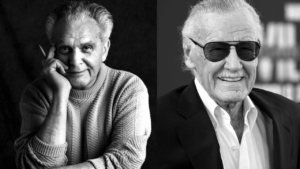
In close collaboration with Jack Kirby, whose dynamic art breathed life into these characters, the Fantastic Four came together. Kirby’s artistic style was as much a hallmark of the team as their powers. His drawings captured the vibrant energy and complexity of their world, turning the simple act of stretching an arm or bursting into flames into a visual marvel.
The Fantastic Four weren’t just a standalone hit. Their popularity paved the way for what’s now known as the Marvel Universe. Their success demonstrated that there was a hunger for stories that mixed heroism with human elements, encouraging the creation of more marvel heroes and teams.
For those interested in understanding how superhero dynamics evolved, the story of their creation is crucial. It showcases how creators can inspire characters who grow beyond their panels, influencing generations of storytelling in comics, films, and beyond. Their legacy reminds us of the power of embracing imperfections and the appeal of characters who feel as real as their readers.
As an Amazon Associate, I earn from qualifying purchases.
Transformation and Characters: The Fantastic Four’s Origin Story
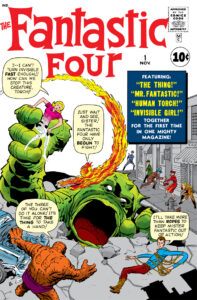
The origin of the Fantastic Four (Fantastic Four #1, 1961) begins with an ambitious space mission conceived by Reed Richards, a visionary scientist with dreams of exploration and discovery. Determined to test his experimental spacecraft, Reed enlisted the help of his fiancée, Susan Storm, her fearless brother Johnny, and his best friend, ace pilot Ben Grimm. However, before the mission even began, Ben expressed serious concerns about the ship’s ability to withstand the dangers of space, particularly cosmic radiation. Despite his warnings, Reed’s eagerness to proceed—and the looming pressure to outpace other nations in the space race—led them to launch anyway. As they ventured into space, the crew encountered an unexpected cosmic storm, bombarding the ship with intense radiation. Exposed to cosmic rays, the team experienced transformations that went far beyond their imaginations.
Meet the Fantastic Four
Each member of the Fantastic Four received unique powers that would define their role in the team—and in the larger Marvel Universe.
Reed Richards (Mr. Fantastic) –
- Powers: Reed has the ability to stretch his body into any shape, allowing him to extend, flatten, or twist himself to extraordinary lengths. His powers are a physical manifestation of his flexible thinking and adaptive approach to problems, reflecting his brilliance as a scientist with expertise in fields ranging from physics to engineering and beyond.
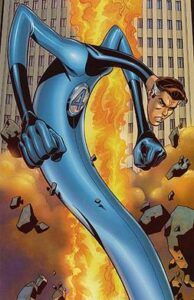 Character Dynamics: Reed’s obsession with science often causes him to become consumed by his work, leading him to neglect his personal relationships, particularly with his wife, Sue Storm. This tendency has been a recurring source of tension, as Reed struggles to balance his drive for discovery with the emotional needs of those closest to him. Perhaps one of Reed’s greatest internal struggles stems from his guilt over the cosmic storm that transformed the team. He was the one who designed the experimental spacecraft and insisted on the mission, even after Ben Grimm voiced concerns about its readiness to handle cosmic events. When the storm bombarded the ship, resulting in their transformation, Reed took the blame for the unforeseen consequences. He felt responsible for altering the lives of his fiancée, best friend, and Johnny in ways that could never be undone. This burden of guilt has shaped his leadership style; he’s fiercely protective and often willing to risk everything to find solutions that could improve their conditions or protect them from further harm. His scientific curiosity has driven the team to extraordinary adventures, but it has also led them into dangerous situations, reinforcing Reed’s internal conflict between his sense of responsibility and his thirst for knowledge.
Character Dynamics: Reed’s obsession with science often causes him to become consumed by his work, leading him to neglect his personal relationships, particularly with his wife, Sue Storm. This tendency has been a recurring source of tension, as Reed struggles to balance his drive for discovery with the emotional needs of those closest to him. Perhaps one of Reed’s greatest internal struggles stems from his guilt over the cosmic storm that transformed the team. He was the one who designed the experimental spacecraft and insisted on the mission, even after Ben Grimm voiced concerns about its readiness to handle cosmic events. When the storm bombarded the ship, resulting in their transformation, Reed took the blame for the unforeseen consequences. He felt responsible for altering the lives of his fiancée, best friend, and Johnny in ways that could never be undone. This burden of guilt has shaped his leadership style; he’s fiercely protective and often willing to risk everything to find solutions that could improve their conditions or protect them from further harm. His scientific curiosity has driven the team to extraordinary adventures, but it has also led them into dangerous situations, reinforcing Reed’s internal conflict between his sense of responsibility and his thirst for knowledge.
Sue Storm (Invisible Woman)
- Sue Storm (Invisible Woman)
Powers: Sue initially possessed the ability to turn invisible at will, but her powers soon expanded to include the creation of powerful, invisible force fields. She can shape these force fields into barriers, weapons, or even lift and move objects, making her one of the most versatile and powerful members of the team. Her abilities allow her to protect herself and others, but she can also use them offensively, demonstrating her strategic mind and adaptability in combat. 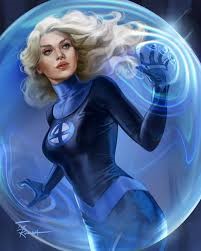 Character Dynamics: Sue is often regarded as the heart of the Fantastic Four, acting as the glue that holds the team together. She serves as a mediator between Reed, Johnny, and Ben, balancing their contrasting personalities with her calm, nurturing demeanor. However, Sue’s strength goes beyond her role as a peacemaker; she is fiercely independent and assertive, capable of taking charge and leading the team when needed. Over the years, Sue has evolved from her early portrayal as a damsel in distress to a formidable superhero in her own right, commanding respect and demonstrating her tactical prowess in battle. Sue’s assertiveness is evident in her willingness to stand up to Reed, even when it challenges their marriage. During Marvel’s Civil War storyline, when superheroes were forced to choose sides over the Superhuman Registration Act, Sue and Reed found themselves on opposite ends of the conflict. Reed supported the act, believing in regulation, while Sue opposed it, valuing freedom and privacy. Her conviction was so strong that she temporarily left Reed, showing that she would not compromise her principles, even at the cost of their relationship. This moment highlighted Sue’s strength of will and independence, proving that she was not just a supportive partner but a leader capable of making difficult decisions.
Character Dynamics: Sue is often regarded as the heart of the Fantastic Four, acting as the glue that holds the team together. She serves as a mediator between Reed, Johnny, and Ben, balancing their contrasting personalities with her calm, nurturing demeanor. However, Sue’s strength goes beyond her role as a peacemaker; she is fiercely independent and assertive, capable of taking charge and leading the team when needed. Over the years, Sue has evolved from her early portrayal as a damsel in distress to a formidable superhero in her own right, commanding respect and demonstrating her tactical prowess in battle. Sue’s assertiveness is evident in her willingness to stand up to Reed, even when it challenges their marriage. During Marvel’s Civil War storyline, when superheroes were forced to choose sides over the Superhuman Registration Act, Sue and Reed found themselves on opposite ends of the conflict. Reed supported the act, believing in regulation, while Sue opposed it, valuing freedom and privacy. Her conviction was so strong that she temporarily left Reed, showing that she would not compromise her principles, even at the cost of their relationship. This moment highlighted Sue’s strength of will and independence, proving that she was not just a supportive partner but a leader capable of making difficult decisions.
Johnny Storm (The Human Torch)
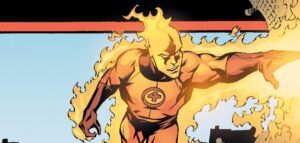
- Powers: Johnny can ignite his body at will, turning into a living flame. He can fly and generate intense heat, which he uses to launch fireballs or create barriers of flame. His signature phrase, “Flame on!”, activates his powers.
- Character Dynamics: The impulsive, brash, and thrill-seeking member of the group, Johnny often acts without thinking, leading to trouble. However, his heart is always in the right place. His relationship with Ben Grimm, marked by constant pranks and brotherly bickering, is one of the comic’s enduring highlights.
Ben Grimm (The Thing)
- Powers: Ben’s transformation into the Thing endowed him with superhuman strength and durability, turning him into a massive, rock-skinned figure. His powers make him nearly invincible, capable of withstanding extreme physical damage, and give him the ability to lift incredibly heavy objects. Despite these advantages, Ben views his transformation as a curse, longing for the humanity he lost when he became the Thing. His rocky form is a constant reminder of the normal life that was taken from him, which fuels his deep-seated desire to be human again.
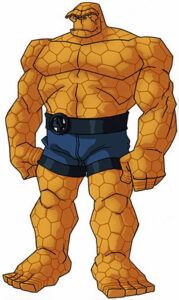 Character Dynamics: Beneath Ben’s rugged, rocky exterior lies a heart of gold. He’s often the emotional core of the Fantastic Four, bringing humor, warmth, and loyalty to the team. However, Ben struggles deeply with his identity, as his monstrous appearance makes him feel isolated and out of place in a world that judges by appearances. This struggle has been central to his character, as he grapples with acceptance and self-worth. His journey has resonated with fans as a poignant metaphor for anyone who has felt different or alienated.
Character Dynamics: Beneath Ben’s rugged, rocky exterior lies a heart of gold. He’s often the emotional core of the Fantastic Four, bringing humor, warmth, and loyalty to the team. However, Ben struggles deeply with his identity, as his monstrous appearance makes him feel isolated and out of place in a world that judges by appearances. This struggle has been central to his character, as he grapples with acceptance and self-worth. His journey has resonated with fans as a poignant metaphor for anyone who has felt different or alienated.- Ben’s friendship with Reed Richards is deep-rooted, dating back to their college days. However, his transformation into the Thing has tested this bond. While he respects and trusts Reed, Ben’s frustration often stems from Reed’s inability to find a way to reverse his condition. This tension has led to moments of conflict, as Ben sometimes feels betrayed or abandoned by his friend’s unfulfilled promises. Despite this, Ben remains fiercely loyal to the team, and his catchphrase, “It’s clobberin’ time!”, embodies his resilience and determination in the face of adversity.
As you can see, these transformations weren’t just physical—they brought about deeper psychological shifts within each character. While their powers proved invaluable, it was their ability to tackle personal changes and emotions that made them relatable and enduring. Readers see themselves in these heroes, prompting curiosity and empathy for their inner battles.
The Rise of the Fantastic Four
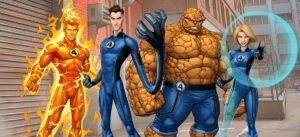
The Fantastic Four revolutionized the superhero genre by combining thrilling adventures with profound family dynamics. Unlike traditional superheroes focused solely on saving the day, this unique team was driven by a spirit of exploration, confronting formidable villains and navigating uncharted dimensions. Their stories not only featured cosmic threats but also delved into the personal struggles of the characters, particularly Ben Grimm’s emotional battle with his transformation into the Thing.
This innovative narrative approach pushed the boundaries of comic storytelling, prompting readers to consider the infinite possibilities of existence and discovery. The Fantastic Four’s complex relationships allowed them to resonate deeply with audiences, as they dealt with not just external challenges but also internal conflicts typical of any family.
By showcasing real emotions and relatable struggles, the Fantastic Four set a new standard for character development in comics. They demonstrated that heroism encompasses more than just epic battles; it also involves confronting everyday challenges and navigating personal relationships. This depth of storytelling forged a lasting connection with fans, who found reflections of their own lives within the extraordinary journeys of Marvel’s first family.
The Fantastic Four’s Most Intriguing Villains
Among the myriad of foes faced by the Fantastic Four, some villains became iconic nemeses who brought forth challenges that tested the team’s unity, resolve, and ingenuity. Check out these characters that the team encountered in their first few years of publication. These villains made such an impression that they have popped up over the years when you least expect them.
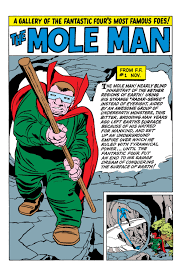 The Mole Man
The Mole Man
In Fantastic Four #1, the team faced their first villain—the Mole Man. Beneath the surface of the Earth, the Mole Man, a once-shunned scientist, had built an empire of monsters. He sought revenge on the surface world, and the Fantastic Four were his first challenge. Although his subterranean army was formidable, the team managed to stop his attacks. This early battle established the team’s dynamic: Reed’s leadership, Sue’s defensive force fields, Johnny’s fiery offense, and Ben’s brute strength.- Namor the Sub-Mariner
Namor, one of Marvel’s earliest heroes, returned as an antagonist for the Fantastic Four in Fantastic Four #4 (May 1962). The issue, written by Stan Lee and drawn by Jack Kirby, reintroduced Namor as a complex character torn between his love for Susan Storm and his desire to reclaim the surface world for his underwater kingdom, Atlantis. Namor’s emotional connection to Sue created tension within the team, especially for Reed. Though Namor often fought against the Fantastic Four, his presence added layers to the storylines—blurring the line between hero and villain. (For more on Namor, check out my post Who Is Namor the Submariner?) 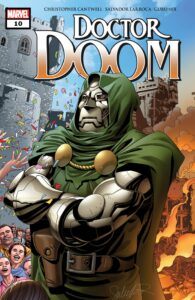 Doctor Doom
Doctor Doom
Perhaps the most iconic villain in the Fantastic Four’s rogues’ gallery is Doctor Victor Von Doom. First appearing in Fantastic Four #5 (July 1962), Doctor Doom was a former friend of Reed Richards who became his greatest enemy. Doom, the ruler of the fictional nation of Latveria, was a genius scientist and master of mystic arts. His rivalry with Reed went beyond simple power struggles—it was a clash of ideologies. Doom believed in ruling with an iron fist, while Reed stood for freedom and discovery. Doctor Doom’s complex character has since made him one of Marvel’s greatest villains. Since Doom is set to appear in the MCU, we will need to write more about him in future blogs!- The Puppet Master
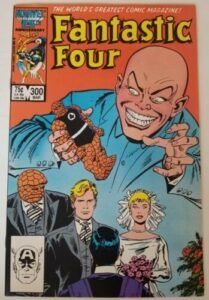 The Puppet Master, introduced in Fantastic Four #8 (November 1962), brought a more personal conflict for the team. Philip Masters, the stepfather of Ben Grimm’s love interest, Alicia Masters, had the ability to control people using puppets made from radioactive clay. His manipulation of others, including the Fantastic Four, posed a unique threat. Alicia, a blind sculptress, became a central figure in the team’s dynamic, particularly in her relationship with Ben. Her love for him, despite his monstrous appearance, humanized Ben and became a cornerstone of his character arc.
The Puppet Master, introduced in Fantastic Four #8 (November 1962), brought a more personal conflict for the team. Philip Masters, the stepfather of Ben Grimm’s love interest, Alicia Masters, had the ability to control people using puppets made from radioactive clay. His manipulation of others, including the Fantastic Four, posed a unique threat. Alicia, a blind sculptress, became a central figure in the team’s dynamic, particularly in her relationship with Ben. Her love for him, despite his monstrous appearance, humanized Ben and became a cornerstone of his character arc. - Kang the Conqueror
Though Kang the Conqueror’s history spans multiple time periods, his early encounters with the Fantastic Four left a significant mark. First appearing as Rama-Tut in Fantastic Four #19 (October 1963), Kang was a time-traveling tyrant who sought to conquer different eras. His complex history involves multiple identities across various comics, but his role in shaping the Fantastic Four’s stories remains vital. (For a deeper dive into Kang’s convoluted history, check out my post Where Did Kang Come From: Discovering the History of MCU’s “Newest” Villain). - Galactus and the Silver Surfer
The arrival of Galactus, the Devourer of Worlds, in Fantastic Four #48 (March 1966) was a game-changer not only for the team but for Marvel Comics as a whole. Written by Stan Lee and drawn by Jack Kirby, this storyline introduced cosmic storytelling into the Marvel Universe. Galactus, a godlike being who consumed entire planets, was initially opposed by the Silver Surfer, his herald. This arc showed the Fantastic Four operating on a universal scale, marking a shift from Earth-bound conflicts to cosmic epics. Galactus became one of the most iconic villains the team ever faced. (For more on Galactus and the Silver Surfer, check out my posts The Evolution Of Galactus In Marvel Comics And Films and Who Is The Silver Surfer?)
These villains, each bringing their unique brand of adversity, continually tested and shaped the Fantastic Four, binding the team closer while revealing the strengths and vulnerabilities essential for growth and storytelling.
The Evolution of the Fantastic Four
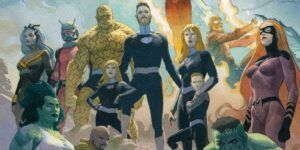
From the start, the Fantastic Four were about more than just powers—they were about family. Over the years, their family expanded, reflecting the enduring theme of unity.
- Franklin and Valeria Richards: Franklin, a mutant with reality-warping abilities, and Valeria, a child prodigy, brought new dynamics to the team. Their presence forced Reed and Sue to balance superhero duties with parenthood, and their children’s safety often became a central concern.
- New Members Over Time: Black Panther, She-Hulk, and Spider-Man have all temporarily joined the team, each bringing their unique skills and personalities to the group. These additions highlighted the Fantastic Four’s ability to adapt and grow, even as their core remained the same.
- Ben Grimm’s Family and Johnny’s Love Life: The addition of Ben’s adopted Kree-Skrull children and Johnny’s romantic entanglement with the alien Sky provided fresh storylines, showing the team’s continued evolution and engagement with the wider Marvel Universe.
Check out these action figures on Amazon now!

Reflections on Adaptations and Media Appearances
The Fantastic Four have not remained confined to comic books. Their presence has extended to various adaptations, including animated series and films. Each attempt to bring their story to the screen has faced its own set of challenges and successes.
Animated series introduced them to a larger, often younger audience, capturing the excitement of their adventures and their family-like bond. These shows balanced fidelity to the source material while making the stories accessible to viewers who might be new to comics.
Live-action films have offered their own take on the comics, sometimes deviating significantly from the original narratives. With each adaptation comes the challenge of faithfully capturing the essence of these beloved characters—something that has met with mixed results and spurred lively debates among fans.
As these adaptations continue to evolve, they play a significant role in introducing new fans to the Fantastic Four, celebrating their legacy while providing fresh perspectives. For readers looking to explore these characters beyond the comics, these adaptations offer both entertainment and a new way to engage with Marvel’s First Family.
Buy The Thing in disguise! – POP Funko
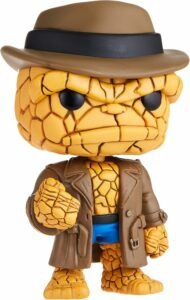
Evolution and Legacy in Modern Storytelling
Over the years, the Fantastic Four have evolved in ways that reflect not only the changes within the comic book industry but also broader societal shifts. Their stories have adapted to new generations of readers while staying true to their core values of family and exploration.
In recent years, we’ve seen them tackle issues that resonate with contemporary audiences. From addressing social justice themes to exploring complex familial dynamics in a modern context, their stories have grown with the times. This evolution keeps them relevant and engaging for new readers while maintaining appeal for long-time fans.
Their legacy extends beyond comic pages; they have influenced how superhero stories are told across various mediums. The Fantastic Four pioneered the idea of flawed, relatable heroes, which has since become a staple in the storytelling of many beloved franchises.
As storytelling continues to evolve, the Fantastic Four serve as a guiding light for creators. Their blend of adventure, drama, and real-world issues provides a blueprint for crafting narratives that connect on multiple levels.
For fans and storytellers alike, revisiting the Fantastic Four’s rich history offers insights into the possibilities of blending mythic and relatable aspects to create stories with impact.
Tease for Future Blogs
As we wrap up our journey through the origins and rise of the Fantastic Four, there’s so much more to discover about Marvel’s First Family. Each member’s growth, their battles against iconic villains, and the intricate family dynamics add rich layers to their stories. Here’s a glimpse of what’s coming next in our exploration:
In “Facing the Threats: The Fantastic Four’s Greatest Villains,” we’ll dive into the complex conflicts and resolutions that define their most formidable foes. Characters like Namor and Dr. Doom didn’t just serve as adversaries; they helped shape narrative arcs, enriching the drama and tension in the Fantastic Four’s adventures.
“Cosmic Encounters: The Fantastic Four and Their Battles with Galactus and the Silver Surfer” promises to take us on an epic journey filled with moral dilemmas and cosmic consequences. We’ll explore how these monumental battles not only tested the team’s limits but also expanded the horizons of their narrative universe.
Family dynamics lie at the heart of the Fantastic Four, and in “Family Matters: The Kree, Skrull, and New Additions to the Fantastic Four,” we’ll investigate how new members and evolving personal relationships impact their journey. From Ben Grimm’s family ties to Johnny’s blossoming romance, these narratives add depth and warmth to their saga.
No exploration would be complete without addressing their most intense confrontations. In “The End of All Things: The Fantastic Four’s Battle Against the Griever,” the team faces one of their most personal threats yet. This blog will weave together themes of legacy, courage, and family that have been central throughout their storied history.
Stay tuned for these upcoming installments, as we continue to unveil the complexities and adventures of the Fantastic Four!
Conclusion

From the moment Fantastic Four #1 hit the stands, the team captivated comic readers. What set them apart from other superhero teams was their realistic relationships and struggles. They weren’t perfect—Reed could be too focused on science, Ben struggled with his monstrous form, Johnny was brash and impulsive, and Sue often had to mediate between them. But this made them feel human, even as they faced cosmic threats.
The Fantastic Four also introduced readers to new worlds, characters, and concepts that would shape Marvel Comics for decades. From the Negative Zone to the Skrulls, to cosmic entities like Galactus, the Fantastic Four’s adventures pushed the boundaries of superhero storytelling. Readers were treated to tales that not only entertained but also made them think about family, loyalty, and what it meant to be human.
The popularity of the Fantastic Four spawned spin-offs, crossovers, and adaptations into other media, from animated series to the big screen. While their cinematic journey has had its ups and downs, the Fantastic Four remains one of Marvel’s most enduring and beloved creations.
For readers, their stories compel us to look at our own relationships and challenges with a fresh perspective and to think about how we all manage to balance our individual roles within a bigger community.
I invite you to share your favorite Fantastic Four stories and moments, as these engagements enrich the community and deepen our collective appreciation. Follow along for more explorations into their legacy and discover how they continue to influence and inspire.
This post contains affiliate links. If you make a purchase through these links, I may earn a commission at no extra cost to you.
If you would like to start reading Fantastic Four but don’t know where to start, check out this video from TheComicBookReport.
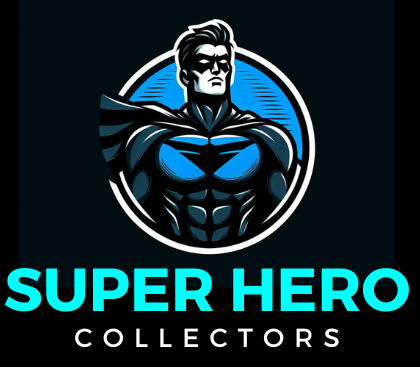
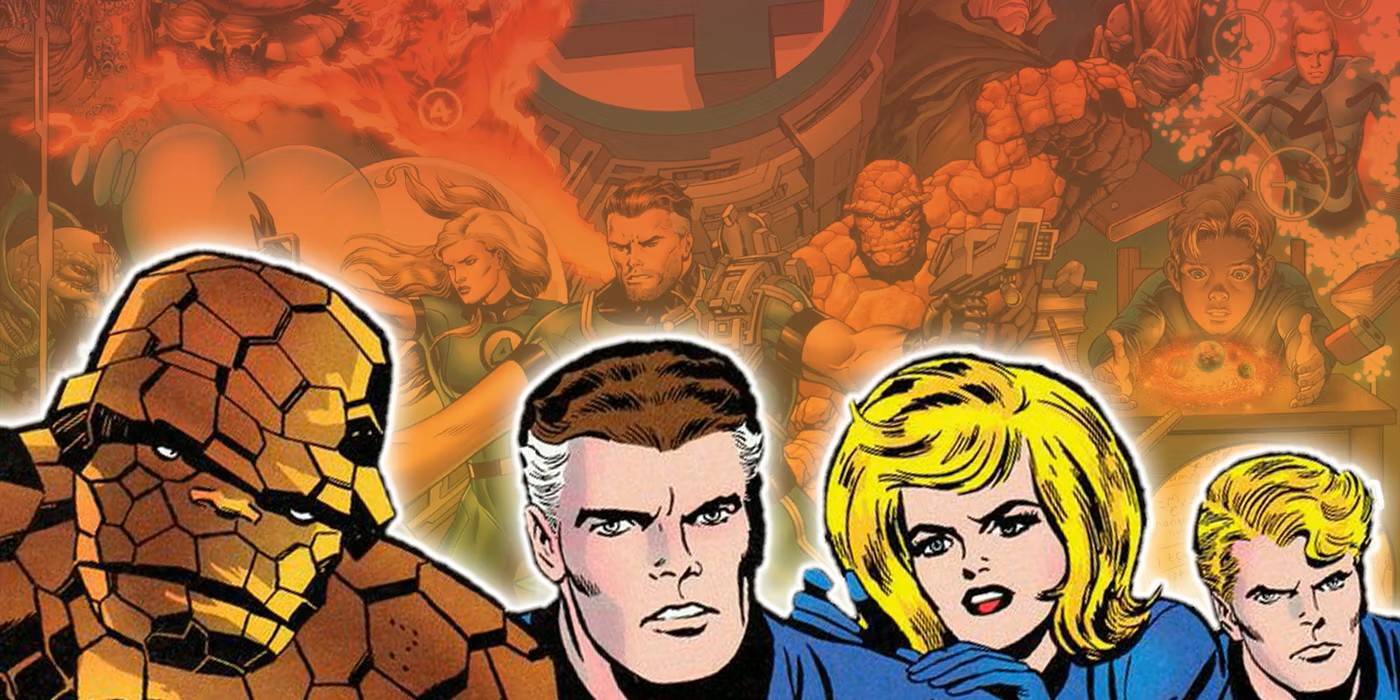
Wow! I had no idea If how the Fantastic Four were born. So to speak. Their relationships within the group add another level of complexity to the storylines. Lee really was quite a revolutionary when it came to his writing. His character development and plot creations made him a stand out. Do you think he had the biggest impact on comics? The imagination just astounds me along with his creativity. He took comics to another level.
Hi Lyn,
Thank you so much for your thoughtful comment! I’m glad you enjoyed learning about the origins of the Fantastic Four and how their relationships add depth to their stories. You’re absolutely right—Stan Lee’s approach to character development and plot was revolutionary. He created heroes who were relatable, flawed, and often had complicated relationships, which made the stories feel more real and engaging.
As for whether Lee had the biggest impact on comics, I’d say he was certainly one of the most influential figures. Along with Jack Kirby and Steve Ditko, Lee redefined what superhero comics could be. He brought a new level of depth and realism, showing that heroes could struggle with personal issues while still saving the day. His creativity, along with his ability to collaborate with talented artists, truly elevated the medium.
Thanks again for your comment, Lyn! Feel free to share your favorite Fantastic Four stories or any other Marvel characters that stand out to you. I’d love to hear your thoughts!
Best,
Scott
What a fascinating story about how the Fantastic Four came about. I often wondered when it started, so I am very pleased that I came across this blog post. To find that the family was really at the heart of their creation, makes me realise why the characters are so popular with all generations.
Do you think that Lee was the most forward thinking of the cartoon writers of the time? Did Lee pave the way for other cartoon characters? Thank you for sharing your expertise.
Thank you for your thoughtful comment, LineCowley! I’m glad you found the origins of the Fantastic Four as fascinating as I do. Their emphasis on family dynamics certainly set them apart from other superhero teams of the time and has contributed to their enduring popularity across generations.
As for Stan Lee, he was indeed a trailblazer in the comic industry. His ability to create relatable characters with real-life problems was revolutionary, making superheroes more accessible to readers. Lee’s focus on character development and interpersonal relationships laid the groundwork for a more complex storytelling approach in comics, influencing countless creators who followed.
It’s incredible to see how his vision not only shaped Marvel but also paved the way for more diverse and nuanced characters in cartoons and comics. Stay tuned! have plans to write a post about Stan Lee in the near future.
Thank you for engaging with the post, and I appreciate your kind words!
– Scott
I love how the Fantastic Four transformed the superhero genre by focusing on family dynamics! It’s refreshing to see heroes who not only save the world but also deal with everyday issues. Their interpersonal struggles make them so relatable, and it’s a reminder that even superheroes have their challenges.
The way each character embodies real human struggles is what sets the Fantastic Four apart. Reed’s obsession with science and its toll on his relationships, Sue’s evolution into a strong leader, Johnny’s impulsiveness, and Ben’s journey of self-acceptance create such rich storytelling. It’s fascinating how Marvel made them feel so human while still being extraordinary!
Hi Kavitha!
Welcome back. I appreciate your comments and adding to the discussion here.
Please continue to come back as we explore more insights into the Fantastic Four!
– Scott
Loved this deep dive into Marvel’s first family! The Fantastic Four not only changed the way we see superheroes but also brought family dynamics into the heart of comic book storytelling.
Their mix of superpowers with real-life emotions has always made them so relatable. I especially enjoyed the insights on their origin story and how each member’s powers reflect their personalities. The section on their iconic villains, like Doctor Doom and Galactus, really shows how these enemies helped shape the team’s evolution.
Who’s your favorite Fantastic Four member, and why?
HI Roopesh!
Thank you for reading and adding to the discussion. The creation of the FF certainly did change the landscape of superhero storytelling!
I think my favorite would be The Thing. His struggles with identity and acceptance of who he is really touches me. I also enjoy his humor and banter with Johnny.
I hope you come back for more superhero fun!
– Scott
I love this blog. My husband and children are very into their comics and superhero’s which has led me down this path. I love how you have described past history and origins of the Fantastic Four alluding specifically to character detail including the villains. The future of the Fantastic Four has been interesting and is ever evolving. I look forward to your next blog.
Hi Nikki!
Thank you so much. I’m glad to hear your family are superhero fans! Please share my site with your husband so that he can enjoy the journey!
Please come back for more superhero fun!
– Scott
Hey Scott,
I just finished reading your awesome article about the Fantastic Four, and I’m seriously impressed! As a huge comic book fan, it’s so cool to see someone give Marvel’s First Family the attention they deserve. You did an amazing job mixing their history, characters, and stories all together.
The way you broke down their personal lives and how Stan Lee and Jack Kirby created them in 1961 really stood out. You clearly understand and respect these characters!
I especially liked how you talked about each member’s special powers and how they’ve grown. From Reed’s super-smart brain to Sue’s hidden strength, Johnny’s fiery attitude, and Ben’s tough yet kind heart, you really captured what makes them awesome.
Your part about the villains was super interesting too. Characters like Dr. Doom and Namor make the Fantastic Four’s stories so much better, and you explained their roles really well.
And props for showing how the Fantastic Four have shaped Marvel’s universe and even influenced other stories. Your article reminded me why these characters are still so loved by fans of all ages.
Thanks for this amazing read! It made me want to dive back into the Fantastic Four’s adventures.
Keep up the awesome work, Scott. It’s clear you’re a big fan, and that’s what makes your writing so fun to read!
All the Best,
Eric
HI Eric!
Thank you for the kind words and I’m happy to have you as a fan of my site. I really had a lot of fun writing this post. Well, I enjoy writing all of them, actually!
I have an entire series of posts planned for the FF. I hope you don’t miss any of them! AND! I have a post planned where I will write about the great Stan Lee!
Keep coming back for more superhero fun!
– Scott
This piece really dives into the history and growth of Marvel’s legendary Fantastic Four, showcasing their role as the original superhero family. It illustrates how each member, with their unique abilities, has changed throughout the years and the significant influence they’ve had on the Marvel Universe.
When it comes to the relationship between the Fantastic Four and their main foe, Doctor Doom, his backstory and motivations have played a huge role in shaping the team’s story over time. There’s definitely a case to be made for viewing him as a misunderstood antihero instead of just a straightforward villain.
HI!
Thank you for reading and adding to the discussion! I will be writing more about Dr. Doom and his interactions with the Fantastic Four. He is really the #1 villain as he is involved in so many plots. you are right – an argument can be made that he is more of an anti-hero. This may be a good angle to explore in my upcoming article! He did fight against Thanos after initially joining him in the Infinity Gauntlet Saga. I think though that he was just interested in the power of the stones. What do you think about this? Is there anything else you would like to see in a future blog?
– Scott
When talking about superheros, I always have difficulty remembring which superhero is from Marvel and which one is from DC, haha… Personally, I do prefer to watch movies which focused on a group of superheros versus individual superhero as the main lead. This is because not only do I get the chance to see the the power of the individual superhero, I also get the chance to see powers and struggles of more superheros. And also just like The Fantastic Four, the interactions in between the different superheros makes the story more realistic and interesting.
Thanks to this article, I now know that Fantastic Four is the first superhero family!
HI Lynz,
I don’t think you are the only one that has that struggle. I sometimes have to remind my wife which comics are DC and Marvel. I’m glad you were able to learn more about Marvel’s first superheroes!
Please come back for more superhero fun!
– Scott
“This was a great breakdown of the Fantastic Four’s origins and their impact on Marvel’s storytelling. I’m curious—how do you think the family dynamic within the Fantastic Four compares to other superhero teams like the Avengers or the X-Men? Do you think their focus on relationships makes them more relatable to readers? I’d love to hear your thoughts!”
Hi Trever,
Thank you so much for your thoughtful comment! I’m glad you enjoyed the breakdown of the Fantastic Four’s origins and their role in shaping Marvel’s storytelling.
You bring up an excellent point about the family dynamic, which is one of the key aspects that sets the Fantastic Four apart from other superhero teams like the Avengers or the X-Men. Unlike the Avengers, who are more of a team of individuals brought together by necessity, or the X-Men, who are united by a shared experience of being mutants, the Fantastic Four truly function as a family. Their conflicts, challenges, and victories are always framed within the context of familial bonds, which makes their stories feel more personal and relatable.
Their focus on relationships—like Reed and Sue’s marriage, Johnny and Ben’s sibling-like rivalry, and the eventual inclusion of Reed and Sue’s children—adds layers to their adventures that readers can connect with on a more intimate level. It’s less about superheroes saving the world and more about a family facing extraordinary situations together. I think this is why the Fantastic Four resonate so strongly with fans; they reflect the ups and downs of family life, even when they’re exploring the cosmos or battling supervillains.
Thanks again for your comment, and feel free to share any other thoughts or questions you have!
Best,
Scott
Stan Lee was an icon who this world will sorely suffer the loss of. I used to not only collect comics but also sell and trade them along with my sports memorabilia. While most of my trade was in DC, Marvel always held a fondness for the storylines. I love the Fantastic Four, they seemed almost like family and filled many hours as my parents drove us from city to city looking to find good weather for my dad’s business as a sign painter on over-the-road trucks.
HI Andy,
Thanks for reading and adding to the discussion. It’s really cool that you have been a seller/trader of comics memorabilia. That must have been a fun childhood reading comics, especially the FF as you traveled.
I hope you will visit often as we share more superhero fun!
– Scott
You have quite an exhaustive history of the Fantastic Four Series, through many years. You have revealed much information to peak the interest of new and old Super Hero fans. This genre has created a large following over the years because people recognize the evil in the world, and enjoy the “Good triumphs over evil” storyline. Great explanations!
Hi Jeffrey! Thank you for your thoughtful comment. I’m glad you found the history of the Fantastic Four interesting and engaging. It’s true—there’s something timeless about the “good triumphs over evil” storyline, and the Fantastic Four have embodied that spirit for decades. I hope this post piqued your interest in revisiting their adventures or exploring some of the newer ones. Thanks again for your kind words!
Please come back for more superhero fun!
– Scott
I’m so grateful for this comprehensive article on the Fantastic Four. It’s been a blast revisiting their origins and rise to fame. I especially loved reading about their early adventures and the introduction of iconic villains like Doctor Doom. Their relatable family dynamics and the way they balance personal struggles with superhero duties really resonate with me. I’ve always been a fan of their unique powers and the way they complement each other. It’s inspiring to see how their story has evolved over the years, and I can’t wait to see what the future holds for Marvel’s First Family.
Hi Kris! I’m thrilled you enjoyed revisiting the origins and journey of the Fantastic Four. Their unique blend of superpowers and family dynamics really sets them apart, and it’s inspiring to see how their story has endured through decades. Doctor Doom’s introduction was such a game-changer, and I agree that their evolution over the years has been fascinating. I’m also looking forward to seeing what’s next for them, especially in the MCU. Thanks for sharing your enthusiasm!
Please come back for more superhero fun!
– Scott
Hello,
Wow, this is such a comprehensive dive into the origins and journey of the Fantastic Four! The evolution from solo superheroes to a true ‘family’ of heroes, balancing powers with personal struggles, makes them so relatable.
It is fascinating to see how characters like Reed and Ben’s friendship and Johnny’s impulsiveness bring humanity to their superhero personas. And of course, the introduction of iconic villains like Dr. Doom and Galactus really elevated the stakes!
Thanks for this nostalgic deep dive. I am excited to see how the team continues to evolve in the MCU.
Hello Starlight! Thank you for the kind words. I’m so glad you found the post comprehensive and engaging! The Fantastic Four really do stand out because of their balance between superhuman powers and very human struggles, and it’s that dynamic that has made them so beloved over the years. Villains like Doctor Doom and Galactus certainly raised the stakes, making their stories even more compelling. I’m excited too to see how Marvel’s First Family evolves in the MCU—let’s hope they capture that same spirit. Thanks for your comment!
– Scott
It was interesting to read that the Fantastic Four started in the 60s already and that they are related. I didn’t know that. It was interesting to read how the Four came about in a space mission gone wrong as I didn’t know how they received their powers. They were just always in the comics that I read and I never thought about it.
Lee Stan and Jack Kirby have fantastic imaginations to create these four and all the super powers that they have while still keeping it real.
Hi Michel! I’m glad you enjoyed learning about the origins of the Fantastic Four. It’s fascinating how their powers came from that fateful space mission, especially considering how different and unique each ability is. Lee and Kirby’s creativity really shines through, not just in the powers, but also in the way they grounded these characters with real-world issues and relationships. Thanks for sharing your thoughts, and I hope this post has inspired you to revisit some of their classic adventures!
Please come back for more superhero fun as we continue the series on the Fantastic Four!
– Scott
The article on the origins and rise of the Fantastic Four does a great job of tracing the team’s history, emphasizing their influence on the Marvel Universe. As someone who has followed the Fantastic Four since childhood, I appreciate how the article highlights their groundbreaking role, combining superhero adventures with family dynamics and cosmic exploration. The description of their debut in 1961 and subsequent popularity growth resonates deeply, capturing what made them stand out as Marvel’s “First Family.” It’s a must-read for fans of Marvel’s iconic teams!
Thank you so much for your thoughtful comment, Miki! I’m glad you enjoyed the article and that it resonated with you, especially as someone who has been following the Fantastic Four since childhood. It’s always great to hear from long-time fans who appreciate how this team brought something unique to the Marvel Universe, blending superhero action with the complexities of family and cosmic adventures. I hope to explore more of their stories and impact in future posts, so stay tuned—and feel free to share your favorite Fantastic Four moments!
– Scott
This article offers a fantastic look into how the Fantastic Four revolutionized superhero storytelling.
I love how it highlights the way Stan Lee and Jack Kirby created relatable characters that were not just superheroes, but also a family dealing with real human struggles.
The exploration of each character’s powers, dynamics, and internal conflicts makes it clear why the Fantastic Four were groundbreaking for Marvel, shaping not only their universe but also how we perceive heroes today.
It’s great to see the legacy of their influence on modern storytelling still resonating in comics, films, and beyond!
Hi Benjamin,
Thank you so much for your thoughtful comment! I completely agree—Stan Lee and Jack Kirby really transformed the superhero genre by crafting the Fantastic Four as more than just heroes; they made them a family grappling with real-life challenges. It’s fascinating to see how their unique powers and personal dynamics not only shaped their stories but also set a new standard for character development in comics.
The influence of the Fantastic Four is indeed still felt today, both in the comics and in films. It’s a testament to their lasting legacy that we continue to see themes of family, conflict, and growth in modern storytelling. I’m glad you enjoyed the article, and I appreciate you sharing your insights!
Best,
Scott
The Fantastic Four really did redefine superhero storytelling by focusing on the complexities of family life, something quite rare for the genre at the time. Their conflicts weren’t just with villains but with each other, which added layers of emotional depth and realism. It’s interesting to think about how their relationships influenced not just the storylines but how readers connected with them on a personal level. Do you think this focus on family dynamics was the key to their lasting impact, or was it their ground-breaking adventures that really set them apart in the long run? Food for thought!
Thanks for your thoughtful comment, Rick! You make an excellent point about how the focus on family dynamics added a unique layer of depth to the Fantastic Four, making their stories more relatable and emotionally engaging. It’s true that their conflicts weren’t just about fighting villains but also about navigating their relationships with one another. As for your question, I think it’s a combination of both—their groundbreaking adventures captured readers’ imaginations, but it was the family aspect that made the characters feel real and kept fans coming back. I’d love to hear what others think—was it the family dynamics or the epic adventures that set them apart in the long run?
Hope to hear from you again!
– Scott
Thank you for writing this fantastic article on Marvel’s First Family! It’s amazing to see how the origins and rise of the Fantastic Four set the stage for so much of the Marvel Universe. The blend of science fiction, family dynamics, and adventure makes their story timeless, and your article does a great job of capturing that essence! Thanks
HI!
Thank you so much for your kind words! I’m glad you enjoyed the article and felt it captured the essence of the Fantastic Four’s story. Their blend of science fiction, adventure, and family dynamics truly set them apart and helped shape the Marvel Universe as we know it today. It’s always exciting to see how those early stories continue to resonate with fans, even decades later. I appreciate your taking the time to read and share your thoughts!
Please come back for more superhero fun and share with your friends!
– Scott
Wow, what an in-depth and fascinating exploration of the Fantastic Four’s origins! Your analysis of their complex relationships and character dynamics highlights the revolutionary storytelling that Stan Lee and Jack Kirby brought to comics.
How do you think the Fantastic Four’s family aspect influenced the development of subsequent superhero teams in comics?
Thank you so much, Cyril! I appreciate your kind words. The Fantastic Four’s emphasis on family dynamics definitely set a new standard for superhero teams. Unlike other groups that came together out of necessity, the FF were a true family, which brought depth and realism to their interactions. This family aspect paved the way for teams like the X-Men and the Avengers, where complex relationships, internal conflicts, and character development became essential to the storytelling. It wasn’t just about fighting villains; it was about how the team members grew and bonded, which continues to influence superhero narratives even today. I’d love to hear your take on how their family theme impacted other teams!
– Scott
I remember reading the very first Marvel Fantastic Four. In 1961, comic books were beginning to shift into a new era. The story’s freshness and unpredictability made it clear why this issue was a game changer—it was innovative. It had flawed heroes with mysterious powers and a group dynamic not seen before in comics. The pages were filled with Jack Kirby’s explosive artwork, from the Human Torch’s fiery form to the Thing’s rough, rocky physique. The tension between these characters gave it a real human edge that was both exhilarating and relatable—it’s easy to see why this comic redefined the superhero genre and launched Marvel’s rise to prominence.This was especially relevant to a six year old girl suddenly comics became relevant to a female world
Catherine, your comment truly captures the magic of those early issues! It’s amazing to hear from someone who experienced the launch of the Fantastic Four firsthand. You’re absolutely right—1961 marked a new era, and the FF were a game changer. The way Jack Kirby brought these characters to life with his bold, expressive art, and how Stan Lee wrote heroes who had real flaws, fears, and conflicts, was groundbreaking. It’s wonderful that these characters resonated with you as a young girl, showing just how universal and inclusive their stories were. Thank you for sharing your memories, and I hope this post brought back some of that excitement from when you first picked up those comics!
– Scott
This article provides a fascinating look into the origins and rise of the Fantastic Four, detailing their dynamic as Marvel’s first family and their unique blend of human emotions with superhero challenges. The emphasis on their relatable struggles alongside their cosmic adventures makes them stand out. I’m curious, what do you think has been the most significant storyline in shaping the Fantastic Four’s legacy over the years? Thanks for such a detailed exploration…this is a great read for Marvel fans!
Thank you, Steve! I’m glad you enjoyed the deep dive into the origins and dynamics of the Fantastic Four. Their blend of cosmic adventures with very human struggles is what makes them so relatable and enduring. As for the most significant storyline, I’d have to say The Galactus Trilogy stands out. It introduced cosmic-scale storytelling to Marvel and showed that the Fantastic Four could tackle threats beyond Earth while still highlighting their personal dynamics. Another pivotal arc would be The Coming of Doom—Dr. Doom remains their quintessential adversary, and this storyline cemented the team’s role as not just superheroes but a family facing challenges together. Thanks for sparking this discussion; I’d love to hear your thoughts on any other storylines you found influential!
– Scott
I really appreciate the points made about the creation of the Fantastic Four, especially how they marked a shift in superhero storytelling by blending everyday struggles with extraordinary powers. It gave the characters a relatable depth that set them apart from the traditional superheroes of the time. The dynamic family setup and personal conflicts within the team were truly innovative and made for richer, more engaging narratives.
Additionally, the explanation of each character’s transformation, particularly Reed Richards’ internal conflict and Sue Storm’s growth into a powerful leader, was insightful and highlighted how these heroes evolved beyond simple archetypes. Thank you for providing such valuable information!
Thank you so much for your thoughtful comment, Matt! I’m glad you enjoyed the post and appreciated the emphasis on how the Fantastic Four’s creation marked a turning point in superhero storytelling. Stan Lee and Jack Kirby truly revolutionized the genre by infusing their characters with relatable struggles and complex dynamics, making them feel more human and approachable.
It’s great to hear that the sections on Reed Richards and Sue Storm resonated with you. Their evolution, especially Sue’s journey from a supportive team member to a strong leader, really showcases how Marvel moved beyond traditional archetypes. I’m thrilled that you found the insights valuable, and I hope you’ll keep following the series as I explore more about Marvel’s First Family. Feel free to share your favorite Fantastic Four moments or characters—I’d love to hear them!
– Scott
Hi Scott,
What a brilliant deep dive into the origins and impact of the Fantastic Four!
You’ve really captured the essence of what makes Marvel’s First Family so special—especially their blend of human flaws and cosmic heroism.
I’ve always found it refreshing how the Fantastic Four isn’t just a superhero team but a family first and foremost, with all the love, tension, and messiness that entails.
I particularly appreciate your emphasis on the emotional depth of the characters, like Reed’s guilt over the team’s transformation or Ben Grimm’s struggle with his rocky form.
That’s what makes their stories resonate so deeply—their internal conflicts feel just as intense as their battles with villains like Doctor Doom or Galactus.
They’re not just fighting enemies; they’re navigating real relationships and personal demons, which makes them so relatable.
In your opinion, what do you think has been the most transformative storyline for the Fantastic Four?
Was it their early encounters with Doctor Doom, or perhaps the introduction of Galactus and the Silver Surfer?
I’d love to hear your thoughts on which stories truly defined their legacy.
Also, with Marvel’s recent push to incorporate the Fantastic Four into the MCU, how do you think they’ll balance the intimate family dynamics with the larger-than-life cosmic storytelling?
Do you think Marvel will stay faithful to the emotional depth that’s such a core part of the team’s identity?
Thanks again for such a detailed and insightful article! I’m excited to revisit some of these classic storylines—and can’t wait to see how the Fantastic Four continues to evolve in both comics and film.
Hi Raymond,
Thank you so much for your thoughtful and encouraging comment! I’m glad you enjoyed the deep dive into the Fantastic Four’s origins and appreciated the focus on their human qualities. You’ve highlighted exactly what makes them so special to me as well—the blend of cosmic heroism with the messiness of family life. It’s that contrast that makes their stories stand out, and it’s great to see that resonated with you too!
Regarding your question about the most transformative storyline, it’s tough to choose just one because there have been so many pivotal moments. However, I’d say the introduction of Galactus and the Silver Surfer in The Galactus Trilogy (1966) was a real turning point for the team and for Marvel comics as a whole. This storyline didn’t just redefine what a superhero story could be; it introduced truly cosmic stakes and positioned the Fantastic Four as protectors of Earth on a universal scale. At the same time, it showcased their personal struggles—like Reed’s moral dilemma over enlisting the help of the Watcher and Ben’s self-doubt, which makes his eventual heroism even more powerful.
Another transformative arc that comes to mind is The Trial of Reed Richards (1989). It forced Reed to defend his decision to save Galactus’ life, even though it meant countless other worlds would be at risk. This storyline delved deep into Reed’s character, highlighting his unwavering belief in second chances, but also his tendency to make decisions that sometimes alienate those closest to him.
Another great story line was recent, penned by Dan Slott called “Point of Origin.” I really enjoyed this one as it gave a lot of new insights into the backstory of the creation of the Fantastic Four. I will be writing more about this one soon.
As for how the MCU will handle the Fantastic Four, I’m hopeful. Marvel has shown that they can balance intimate character-driven stories with epic scale—Guardians of the Galaxy is a great example of this. If they can capture the essence of the Fantastic Four as a family with real, complex relationships, while still bringing in the larger-than-life cosmic elements, I think we’ll see something truly special. My hope is that they don’t shy away from showing Reed’s internal struggles, Sue’s strength and heart, Ben’s humanity, and Johnny’s lightheartedness, even as they face cosmic threats. The upcoming Fantastic Four film will be a great chance to set this tone, and I’m looking forward to seeing how they bring it all together.
Thanks again for your kind words, Raymond! It’s always a pleasure to engage with readers who share such a passion for these characters. Feel free to share your favorite Fantastic Four moments too—I’d love to hear what stands out to you!
Best,
Scott
This article offers a rich exploration of the origins and legacy of the Fantastic Four, detailing how Marvel’s first superhero team reshaped the landscape of comic book storytelling. The focus on their complex family dynamics and human struggles makes it easy to see why they remain such beloved characters. The insights into their creation and evolution through the years provide a deeper appreciation for their impact on the Marvel Universe. A question for you: Which Fantastic Four storyline do you think best captures the essence of their family dynamic?
Thank you, Marc, for your thoughtful comment! I’m glad you enjoyed the exploration of the Fantastic Four’s origins and their influence on comic book storytelling. Their complex family dynamics and personal struggles are indeed a big part of what makes them resonate with so many fans.
As for your question, there are quite a few storylines that highlight the Fantastic Four’s unique family dynamic, but one that stands out to me is “The Coming of Galactus” arc (Fantastic Four #48-50). This storyline not only introduced the world to Galactus and the Silver Surfer but also showcased the team’s unity, resilience, and the way they rely on each other to overcome impossible odds. It emphasized how their strengths come from their bond as a family, even when facing cosmic-level threats.
Another favorite is Jonathan Hickman’s Fantastic Four run, especially the “Three” storyline, which delves into the team’s relationships, particularly how they cope with loss and responsibility. It explores the idea of family beyond just the core four, including characters like Franklin, Valeria, and other extended members.
I’d love to hear your thoughts! Do you have a favorite Fantastic Four storyline that you feel captures their essence? Thanks again for engaging with the post, and feel free to share it on your favorite social media platforms!
– Scott
Just this morning I was having breakfast with my 23-year-old son and he was sharing his new fascination of comic books. He has followed the marvel characters and their evolution, and I know he will enjoy this website. I’ll be sure to share. I really appreciated the explanation of “flawed characters” and “family dynamics” that are infused in these story lines.It was a long time ago, but I had to introduce reading to my son who resisted reading assignments. I recall bringing comic books into our home. Wished we saved some of them now that I think about it. Not only did reading become enjoyable and an incredible asset to learning but it addresses the reality of real issues in people and in family that could really help a young person understand their surrounding and not feel alone. Thank you
Hi Maria!
Thank you for sharing your adventures of teaching reading to your son. I am glad comics were helpful. Reading comics is more than just mindless entertainment. It involves imagination and learning about determination, honor, and integrity. I hope your son enjoys my website. Please encourage him to engage with the blogs and make comments.
Please come back soon for more superhero fun!
– Scott
“Marvel’s First Family: The Origins and Rise of the Fantastic Four” offers an exciting exploration into the history of one of Marvel’s most iconic teams! It’s fascinating to see how the Fantastic Four has evolved from their debut, shaping the Marvel Universe with their unique blend of family dynamics, adventure, and innovation. The post does a great job highlighting the impact that Reed Richards, Sue Storm, Johnny Storm, and Ben Grimm have had on both the comic world and pop culture, making them timeless characters. For fans of superhero lore and newcomers alike, this deep dive into their legacy is both informative and inspiring, reminding us why these heroes continue to captivate generations. I have to say I really loved reading your posts.
4o
HI Shaun,
Thank you for reading and commenting. I’m glad you enjoyed the post!
Please come back soon
– Scott
The exploration of the Fantastic Four’s origins and evolution captures the unique blend of superhero action and relatable, humanized storytelling that has set Marvel’s First Family apart. It’s fascinating to read about how Stan Lee and Jack Kirby’s vision to create more “human” superheroes led to such a breakthrough. The team’s origin story—especially Reed’s ambition and the unintended consequences on his friends—is a powerful reminder of how character-driven plots make superheroes so impactful. I’m curious, though, if there’s a particular storyline you’d recommend for newcomers that best captures their family dynamic and individual struggles. It seems like each member, from Ben’s internal battles to Sue’s evolving role as a powerhouse, brings a unique perspective that shapes their adventures.
Thank you for this comprehensive dive into the Fantastic Four’s legacy; it’s clear they continue to resonate across generations, and it’ll be interesting to see how Marvel portrays them in future adaptations!
Thank you so much for your thoughtful comment! I’m glad you enjoyed the deep dive into the Fantastic Four’s origins. Stan Lee and Jack Kirby’s approach to creating superheroes who faced very real, human struggles truly set Marvel’s First Family apart, and it’s wonderful to hear that resonated with you as well.
For newcomers interested in exploring the family dynamics and individual struggles of each member, I’d recommend checking out Fantastic Four: The Trial of Reed Richards by John Byrne. This storyline delves into Reed’s complex sense of duty and responsibility, particularly as his decisions impact his loved ones. Another great one is Fantastic Four: Hereafter, where Mark Waid and Mike Wieringo explore the bond and loyalty among the team, especially as they confront the ultimate challenges in their journey through life, death, and beyond.
And, of course, Ben Grimm’s inner battles are spotlighted beautifully in Fantastic Four #51, “This Man… This Monster!” It’s a classic that captures his conflict with his powers, as well as his deep friendship with Reed. Each of these stories highlights the unique perspectives each member brings, making them so much more than just heroes—they’re a family with all the love, conflict, and growth that comes with it.
Thank you again for reading and sharing your thoughts! It’s always exciting to connect with others who appreciate the timeless impact of these characters. Please come back for more superhero fun!
– Scott
What an awesome read! It’s great to dive into the origins of Marvel’s First Family and see how the Fantastic Four set the stage for so many iconic storylines. I loved learning about their impact on the Marvel Universe and how they helped shape the superhero genre. The breakdown of their individual powers and personalities was spot-on—it’s easy to see why they’re still so beloved. Thanks for sharing!
HI Randi!
I’m glad you enjoyed this post! I will be writing more about the Fantastic Four. I hope you don’t miss any!
– Scott
Personally I watched the film though I never read the comics. And I loved it! Yes, the characters of the Fantastic Four sound real-like people, people you can identify with. Honestly, all these characters represent an element of the universe. fire, earth, air and water. I really like this deep dive into the creation of these wonderful characters of Fantastic Four!
Hi Angelce,
Thank you for sharing your thoughts! I’m glad you enjoyed the movie and found the characters so relatable. The Fantastic Four really do have that unique balance of being powerful heroes while still feeling like real people dealing with real-world challenges. You’re absolutely right about the elemental symbolism—they each represent an aspect of nature, which adds a layer of depth to their powers and personalities. It’s one of the things that made them so revolutionary when they were created! I’m glad you liked the deep dive into their origins, and I hope it gave you a new perspective on these characters. Thanks again for reading and commenting!
Don’t miss any of my future posts about Marvel’s First Family!
– Scott
The beginning of the Marvel Universe began the year I was born. It made great reading as a 10-year-old later on while I was growing up. Looking back at the series over time, there was a discussion around the reflection of the family and friends dynamic. The group of two guys, a girl and Thing morphed into Mom, Dad, The Unlce, and the Rottweiler. Over time, Sue outgrew the Mom role, but in the beginning, she was always there to protect the group. Would you agree with this early characterization?
HI MrDon,
That’s great memories that you have! I would agree with that early characterization, though I don’t think I’ve heard The Thing being called a Rottweiler! Even Ben Grimm became a parent later on. He married Alicia Masters, and they adopted a boy and a girl. The boy was Kree and the girl was a Skrull – both of them were trained warriors. I plan to write more about that in the future.
I’m glad you found my website. Please come back for more superhero fun!
– Scott
What a fascinating look at the birth of Marvel’s first family! The Fantastic Four’s debut was a game-changer in superhero storytelling, introducing relatable characters with personal struggles alongside their superhuman feats. I love how their dynamics shaped future Marvel stories. It’s clear that their emotional depth is just as significant as their powers. Do you think the success of the Fantastic Four’s family-oriented approach paved the way for other superhero teams in the Marvel Universe?
Hi Naresh,
Thank you for your thoughtful comment! I’m glad you enjoyed the deep dive into the Fantastic Four’s origins. You’re absolutely right—their debut truly was a game-changer. Unlike many superheroes of that era, the Fantastic Four were portrayed as a real family, with all the complexities and conflicts that come with it. The emotional depth and interpersonal struggles they faced resonated with readers in a way that hadn’t been seen before, adding a new layer to superhero storytelling.
As for your question, I do believe the Fantastic Four’s success played a huge role in paving the way for other Marvel teams. The focus on family dynamics set the stage for groups like the X-Men and the Avengers, where personal relationships are just as central to the story as their battles against villains. It showed Marvel that fans wanted more than just action—they wanted characters they could relate to, who faced problems similar to their own. This approach became a hallmark of the Marvel Universe, shaping its storytelling for decades.
Thanks again for sharing your thoughts! I’d love to hear more about your favorite Fantastic Four storylines or other Marvel teams you think were influenced by their success. Feel free to share!
Best,
Scott